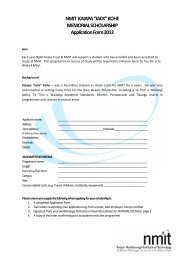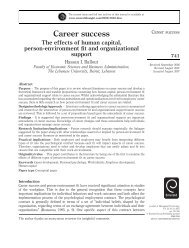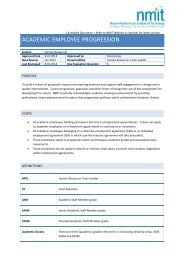Jackson Parry - Leadership, Chp 3, 41-60.pdf
Jackson Parry - Leadership, Chp 3, 41-60.pdf
Jackson Parry - Leadership, Chp 3, 41-60.pdf
- No tags were found...
You also want an ePaper? Increase the reach of your titles
YUMPU automatically turns print PDFs into web optimized ePapers that Google loves.
58 Studying <strong>Leadership</strong>strengthen the leadership relationship in the knowledge that this wasvital to the survival of the group (Shackleton, 1999).The best effort to date to model the co-production of leadership in adynamic way is Leader-Member Exchange (LMX) theory which, basedon repeated empirical observation, argues that leader-follower relationshipsevolve through three distinct phases (Graen and Uhl-Bien, 1995).At the initial 'stranger phase', interactions are largely formal, rule-boundand driven by ~elf- interes t rather than the good of the group. Some relationshipsnever evolve from this stage. However, others may progress toa second phase, the 'acquaintance' phase - a testing phase in which theleader gives the follower the opportunity to take on more responsibilityin return for inside information , and friendship and support. Assumingboth the leader and the follower pass the test, the relationship becomesbased more on mutual trust and respect and less on formal contractualobligations. Ar the final 'mature' phase, there is a high degree of reciprocitybetween leaders and followers; each affects and is affected by theother. Leaders and followers become tied together in productive waysthat go well beyond the traditional hierarchically defined work relationshiptowards a transformational leadership relationship.LMX theory is intuitively appealing. It accords with the experienceswe have had both as follower and as leader. It brings into relief the factthat differences exist in the quality of relationships that leaders have withindividual followers. There are times we have really got on with a bossand there are times when we haven't, and yet others seem to get onfamously with that boss. It also issues a cautionary note in warning leadersof the dangers of being selective in whom they choose to favour as thisfosters divisive in-groups and out-groups within the la rge r group. Leadersare, therefore, encouraged to cultivate high-quality exchanges with all oftheir follo\vers, recognizing that ultimately it always 'takes two to tango'.Keith Grint has noted that leaders can learn a lot about how to leadfrom their followers. He draws an intriguing para llel between the challengeof learning how to lead for the first time and the challenge orlearning how ro become a good parent, noting that 'in both cases, anecounter-intuitively, it is the junior that teach their superordinates howto lead' (2005: 104). In order to do this, open, honest and continua:feedback is essential. Looking back on how we le:1rneri to hecome p:1r·ents we probably should have devoted more time and effo rt to trying rclearn from our children instead of relying on more traditional source- such as our parents, our friends or child-rearing books.The parent--child metaphor, especially in light of our discussion (- .psychoanalytic theories of leadership, is potentially fraught with corr·plications - not least because of its implicitly paternalistic or matern ,::istic view of leadership which all leadership scholars worth their sal t ~',trying to rid the world of. However, we think it's helpful here beel!-'
















